Jira is mostly known as a tool that is designed for managing Agile software development projects. That said, the tool’s capabilities have grown past a single use case long ago. Now, Jira is one of the most flexible solutions on the market, with functionality that will fit any project, from content creation to service desk support.
What are Jira Project Templates?
Project Templates in Jira offer users a preset combination of a workflow, project settings, and issue types. This combo is designed to reflect a very specific type of work.
You don’t need to stick to the default settings of a template. Each and every one of them can be tweaked after the initial project setup.
Still, starting the setup process from scratch can be rather intimidating. This is why Atlassian has introduced a selection of out-of-the-box Project Templates. Think of them as a handy way of getting to a preconfigured, ready-to-go Jira project in minutes?
Good to know
Issue types: Essentially, issue types are a tool that allows you to distinguish between different types of work. They can have their own hierarchy where one issue type, like an Epic, is parent to another issue type, like a Task. Some of the most prominent issue types are Epics, Stories, and Tasks.
More about Issue Types >>>
Workflow: A Jira workflow is a series of statuses and transitions representing how work progresses through different stages in a project. It defines the life cycle of an issue, from its creation to its resolution. In the context of organizing and customizing Jira project data, the workflow plays a crucial role.
More about Jira workflow setup >>>
Which Project Template is right for you?
Let’s take a look at the selection of Project Templates Jira offers to its users.
The first thing you’ll notice is that Jira has many of them. There are 17 categories that I see. This number may be different for you. Each category contains a selection of various templates.
I think that the easiest way of categorizing these templates would be in relation to the product they come from. This may sound counter-intuitive, but the UX team at Atlassian has decided to mix the Project Templates from several different Atlassian Products into one list.
Still, keep in mind that most of these are essentially starter packs of project, workflow, and issue type settings, so most of them function in a similar way.
For example, a Content Management template will have the ASSET issue type for your blog posts, YouTube videos, or TikTok shorts. It will also have a workflow that represents the process of working with creative assets. Your tasks will go from TO DO to DRAFT to IN REVIEW to APPROVED to PUBLISHED.
Similarly, a Sales Pipeline Project Template will have the CUSTOMER issue type, and a workflow consisting of the following statuses: NEW > FOLLOW-UP > CONTRACT SENT > NEGOTIATION > CLOSED WON > CLOSED LOST.
Most of Atlassian’s Project Templates function similarly with respect to the product family they belong to. In simpler words, all Jira software templates will share the same features with one another. The same goes for Service Management or Work Management templates.
All of them are designed as an easy way of starting a project without messing with the settings.
So, let’s take a look at the Products that Atlassian offers as well as their respective Project Templates.
Jira Software Templates
While Jira Software is used for Project Managemet, it is purpose-built for software teams.
Software development Project Templates are designed for agile delivery of software products. Scrum and Kanban projects are two of the most prominent templates in this category. They aim to help teams break down complex projects into more easily manageable tasks.
What makes these project templates special?
- Specific settings that allow you to store work in a backlog.
- Unique reports that can help you track the productivity of your team and identify bottlenecks.
- Integration with DevOps, CI/CD, and QA tools.
List of templates
- Kanban
- Scrum
- Bug tracking
- Top-level planning (Premium)
- Cross-team planning (Premium)
Examples of use cases
- Use the Scrum template if your team works in time-boxed iterations or Sprints. The team will deliver an increment or, according to the Scrum Guide, a stepping stone towards the Product Goal. In simpler terms, you will have a “Done”, usable, and potentially releasable product at the end of every Sprint.
- Use the Kanban template if your team avoids forcing things into time-boxes. You should support a continuous flow of work where the tasks are moved to “Done” when they are completed. You can also limit the number of issues that can be in progress to ensure a reliable flow of work that doesn’t overwhelm the team.
Jira Service Management Templates
Jira Service Management or ITSM (formerly known as Service Desk) is a tool that is designed to help teams receive and process incoming requests. It consists of two parts: a company-facing Service Management solution and a user-facing Customer portal. Please note that you are paying only for the seats of the users in your team. The Customer-facing portal is open, and the number of requests you can receive is unlimited.
Jira Service Management projects offer features for incident management, problem management, change management, request fulfillment, and other IT service management (ITSM) processes. These projects are often configured with service-level agreements (SLAs), queues for ticket triage, and automation rules to streamline service delivery and support workflows.
Think of every project that has Service Management in its name as a Project Template that is derived from ITSM rather than Jira Software.
More about Jira Service Management >>>
What makes these project templates special?
- Separate product with its own pricing
- User-facing customer portal
- Functionality that is unique to ITSM, like functionality for incident management, problem management, and change management
List of templates
- IT Service Management
- IT Service Management (Essentials)
- General Service Management for IT teams
- General Service Management for business teams
- Customer Service Management
- HR Service Management
- Finance Service Management
- Facilities Service Management
- Legal Service Management
- Sales Service Management
- Design Service Management
Let’s look at the primary use cases of JSM:
- IT Teams: Small, mid, or large IT teams can resolve issues and incidents, manage requests, track open requests, and whatnot.
- HR Service Management: HR Teams use it for Employee onboarding, employee offboarding, change requests, answering emails, and for setting up knowledge bases.
- Legal service teams: Employees and customers can set up legal requests, and your team can manage them in a single location.
- Sales teams: Sales reps will benefit from transparent workflows, customization of incoming requests, and overall sales request management options.
- Marketing teams: Admins can use JSM to submit marketing requests, align the teams together, and send notifications to partners. There’s also the 24/7 marketing portal option that provides access to marketing services and offers excellent knowledge-sharing options.
- Design teams: Collect responses and recommendations across various channels like email, phone, and support to instruct the design teams. Stakeholders or managers can request a design change, ask questions and review a design within.
- Finance: Finance teams can manage their budget, spending, and other financial requests with JSM.
- Facilities: JSM offers people a centralized place to log maintenance issues, desk move and equipment requests, etc. and the knowledge portal can give them guidance and context regarding the request process.
- Analytics: You can capture and manage all your analytics data requests in one place. This helps you bring together the data from multiple sources like emails, chats, and portals making the process simpler and more transparent.
- Customer service: Lastly let’s look at the most obvious use case – customer service. JSM helps you build a centralized queue for customer service requests, offers the tools to build a self-help portal, and gives access to goals-oriented SLAs for measuring customer service experiences.
JIRA service management is undoubtedly the absolute powerhouse of managing heavy service management tasks and resolving customer issues. To extend its functionality, the Atlassian Marketplace has various add-ons.
These add-ons help reduce context switching and improve productivity further. Let’s look at some of the most powerful JSM add-ons.
Smart Checklist for Jira
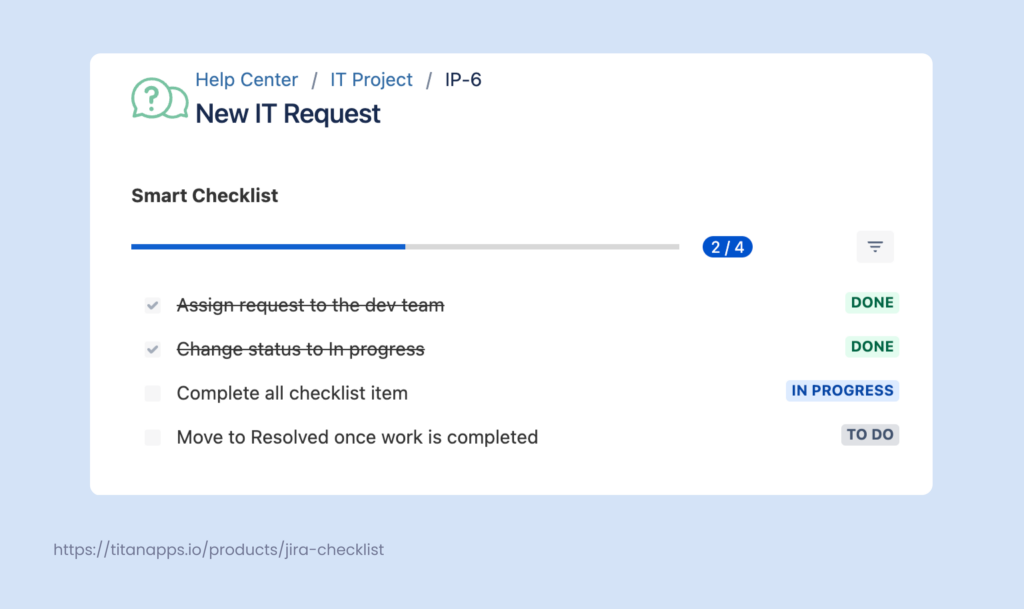
Smart Checklist for Jira allows you to add a checklist to service management tickets. This way your customers will see them view mode only allowing them the comfort of clearly understanding what’s being done to their request.
Jira Work Management templates
Similar to Jira Software, Jira Work Management is a project management tool. The difference is that it is built with business teams in mind. It focuses on tools that are designed around assigning ownership and managing dependencies rather than working in sprints to deliver a product.
What makes these project templates special?
- Unique tools that are not found in other products, like an integrated calendar, inline editable list, summary page, real-time collaboration options, and easy-to-use forms
- Simplified navigation: The tools like the timeline, forms, reports, and summary are all accessible from the menu at the top of the board
- Separate pricing
- Focus on business teams
List of templates
- Project Management
- Task tracking
- New employee onboarding
- Product control
- Sales pipeline
- Go-to-Market
- Web design process
- Document approval
- Campaign Management
- Recruitment
- Budget creation
- Procurement
- Content management
- Personalized task planner
- Month-end close
- Policy management
- Asset creation
- RFP process
- Email campaign
- Lead tracking
- IP Infringement
- Performance review
- Grant funding management
- Nonprofit program management
- Community program management
Examples of use cases
- The task tracking project template is rather lightweight and intuitive. It is designed for tracking personal tasks and is created for people who don’t want to be distracted by excessive functionality
- The Procurement template is designed with the flow of receiving and processing a request for the purchase of new hardware or tools
- A Month-end close project streamlines and simplifies your month-end close process. The workflow, timeline, and calendar features are useful for this task, but you will probably benefit most from integrating approvals into your workflow. Keep in mind that this is a premium feature.
Jira Product Discovery template
Similarly to ITSM and Jira Work Management, the product management category offers access to an entirely different Atlassian product. In this case, it’s the Jira Product Discovery app.
This template is designed to bridge the gap between business and tech teams. It provides a dedicated space for understanding problems, solutions, and their potential impact on the business goals.
What makes these project templates special?
- Separate product with its own pricing
- Great for gathering insights from every team
- Gives product ideas more context
- Keeps the stakeholders and leadership informed on the development process without the distractions of day-to-day tasks
List of templates
- Product Discovery
Use case example
- The Product Management Template is designed for high-level planning. It works great for Product Managers who want a less cluttered medium for communicating goals and progress with the stakeholders.
Additional info and good to know’s
Let’s face it: Jira is not the most user-friendly tool on the market. However, it definitely makes up for the lack of good UI/UX by delivering the most robust selection of project management tools on the market, but figuring all of them out can be quite challenging. Especially to new users.
That’s why I’d like to point out a couple of important decisions you’ll make when creating a Jira project. I am pointing them out because – for some reason – Jira doesn’t.
Project bundles
Project bundles are a selection of several Project Templates you can set up at once. This is a great option when you need to track and manage the work of several teams with different needs. Jira offers a selection of ready-to-go templates, and you can easily create your own bundle.
These can work great for the majority of larger businesses. For example, you can set up separate projects for Product Management, software development, and an internal service desk at once. Or, if you are a marketing agency with several teams, you can create dedicated projects for campaign planning and content creation in one go.
Differences in Pricing
Certain Project Templates require a premium subscription. This is indicated by a purple tag under the template’s name.

Additionally, Project Templates that come from different tools like ITSM will have separate pricing for that specific tool.
Choosing between Team-managed and Company-managed projects
This is yet another very important yet somewhat hidden choice you’ll need to make before creating a new project in Jira.
The question regarding which project type to choose is rather nuanced. So, I’d suggest looking into the official Jira documentation to help make up your mind for sure. Just in case, here is a generalized overview:
Team-managed projects, accessible to anyone on the team, work well for self-governing teams. They control their processes and practices in a self-contained space. These projects are simpler to set up and manage, with project admins having more autonomy without needing a JIRA admin’s involvement.
Company-managed projects, which are set up and maintained by JIRA admins, are the best option for teams that want to collaborate with other teams across several projects consistently, such as sharing a process.
Company-managed projects necessitate the configuration of screens and plans upon which projects are built. As a result, company-managed projects have increased project setup complexity but also the opportunity to standardize workflows across projects that team-managed projects do not.
When a JIRA administrator modifies a scheme or screen, it affects every company-managed project that utilizes that configuration.
But what do I mean by saying that this choice is somewhat hidden?
Sometimes, like in the case of a Software Development project, you will make it on the next step, after selecting a project template.
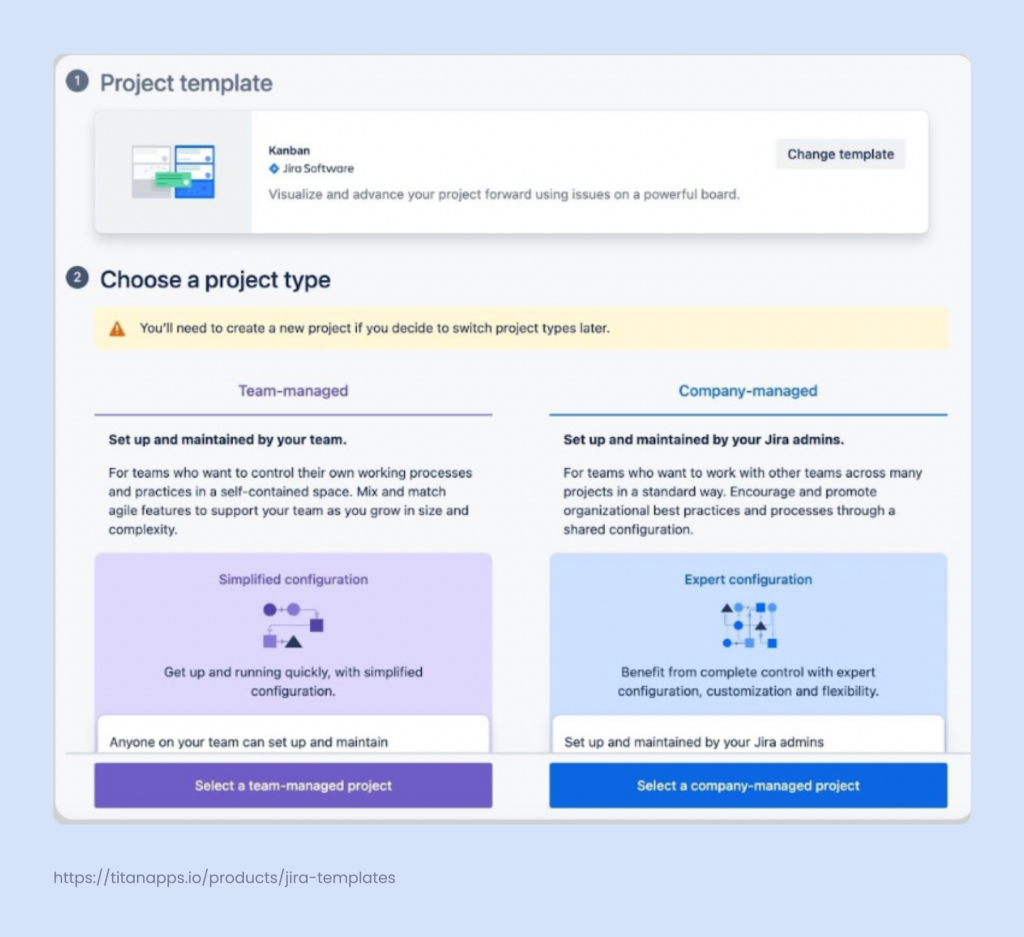
Other times, like with a Project Management or a Go-to-Market Template, you’ll need to expand the options on step 1 to see it.
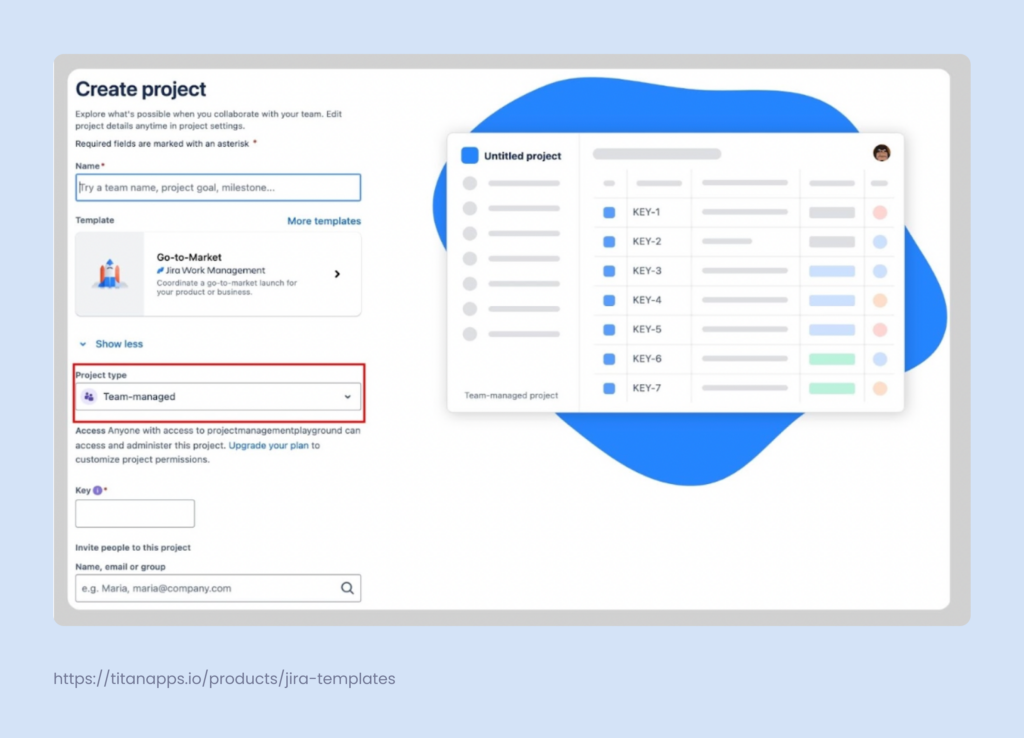
And there are times when the option is locked, like in ITSM. Therefore, I highly recommend deciding whether you’d like a team- or a company-managed project beforehand.
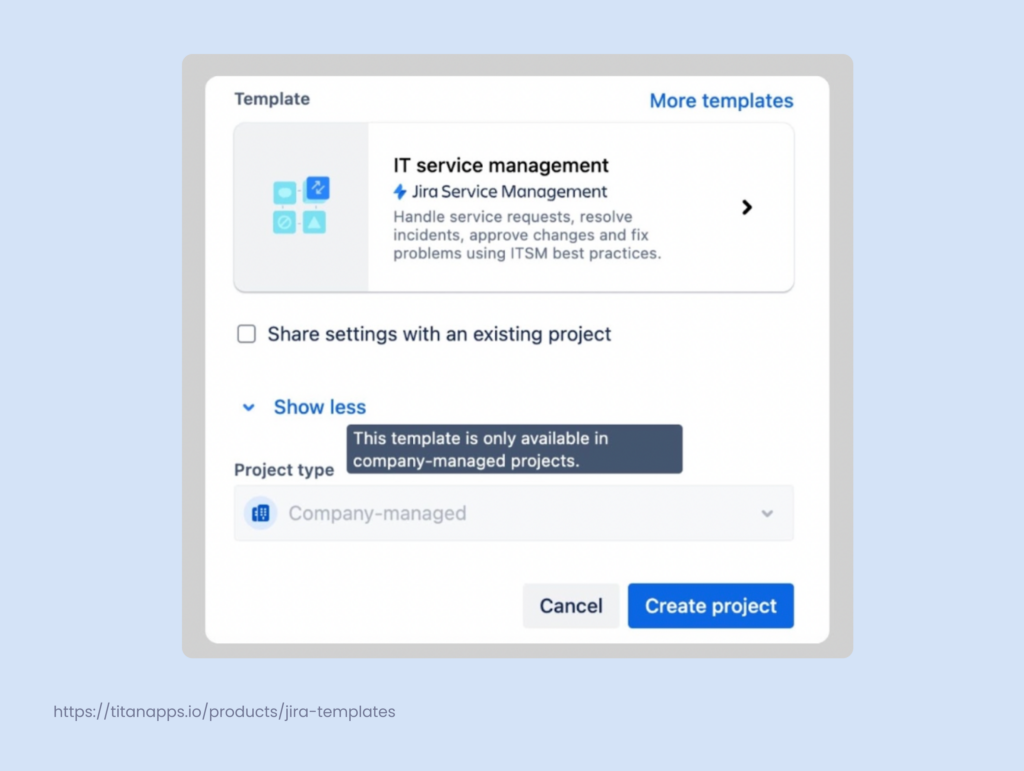
Bonus tip: Templates for Processes
Obviously, the initial setup of a Jira project is only the first stepping stone toward successfully managing your teams. Every project, regardless of size or type, has a wide variety of repetitive or recurring tasks.
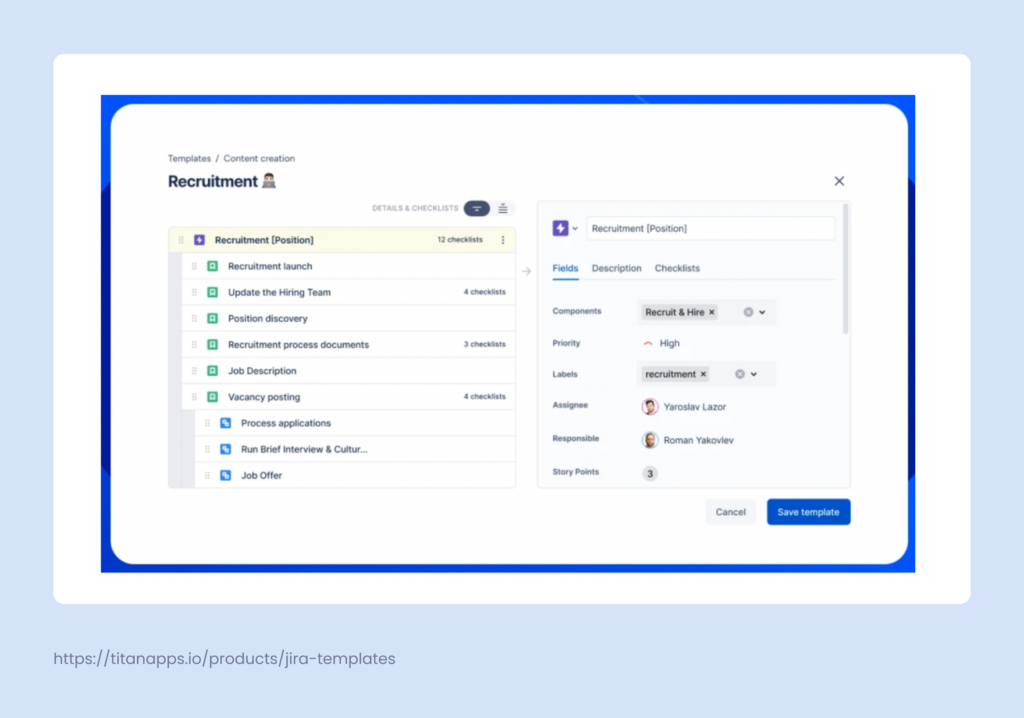
And this is where apps like Smart Templates for Jira come in. Smart Templates is a productivity tool designed to optimize team performance and establish company standards. It allows you to create issues or entire issue hierarchies once and reuse them every time your team needs to report a bug, start the hiring process, onboard a new employee, or launch payroll.
If this seems like something you’d like to consider for your team – give the app a try for free.
Key takeaways
Wrapping one’s head around the wide variety of templates Jira offers can confuse new users. Hopefully, you’ll have an easier time after reading this article. Just try to keep the following key takeaways in mind when setting up a new project:
- The templates that come from the same Jira product have the same functionality. They will differ in certain settings, issue types, and workflow setups.
- You are not locked with the initial settings of your project. Everything is customizable, given you have the need to make the changes.
- Different Jira products have different pricing.
- Certain project templates can only be accessed with a Premium subscription.
I hope this helps on your journey towards realizing the full potential of the Atlassian family of products?
